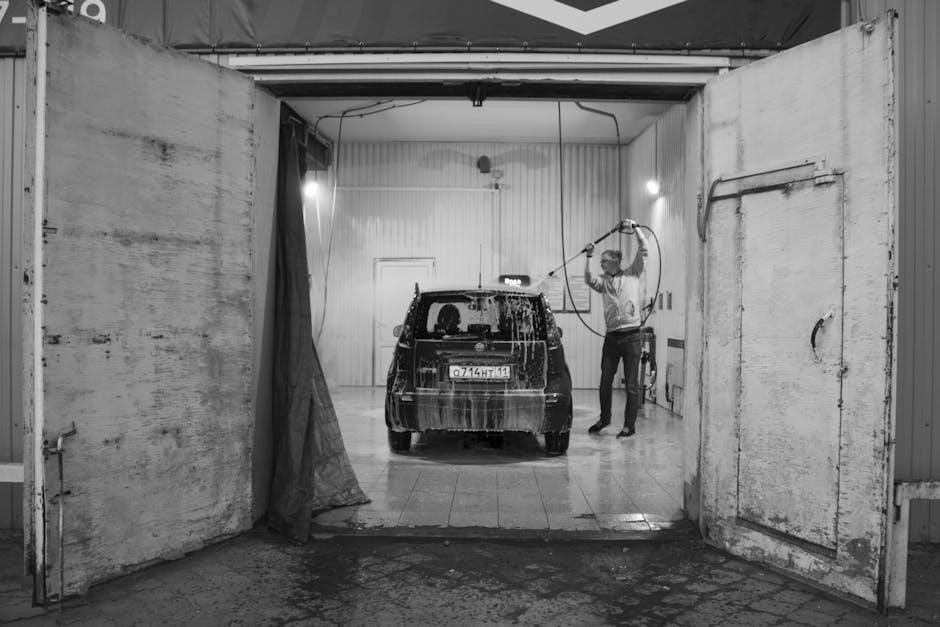Troy-Bilt 3000 PSI Pressure Washer Manual: A Comprehensive Guide
Welcome to your comprehensive guide to the Troy-Bilt 3000 PSI Pressure Washer. This manual offers detailed instructions, safety guidelines, and troubleshooting tips. Whether you’re a first-time user or experienced, this guide will ensure safe and effective operation. Access all the information needed to maintain your pressure washer.
Understanding Your Troy-Bilt 3000 PSI Pressure Washer

The Troy-Bilt 3000 PSI pressure washer is a powerful tool designed for heavy-duty cleaning tasks. It operates at a maximum pressure of 3000 PSI (206.8 BARs) and a flow rate of up to 2;7 gallons per minute (10.2 liters per minute). This high-quality residential system is powered by engines like the Honda GCV190 or GCV170, offering reliable performance for various outdoor cleaning applications. The axial cam pump ensures durability and consistent pressure output.
Understanding the components and features of your pressure washer is crucial for safe and effective use. Familiarize yourself with the engine, pump, spray gun, nozzles, and water inlet connections. The operator’s manual provides detailed diagrams and descriptions of each part. Knowing how these components work together will help you troubleshoot common issues and perform routine maintenance. Always ensure that you have the correct model number for accurate information.
This pressure washer requires final assembly before use, so consult the manual for detailed instructions. Before starting, it’s important to understand the water supply and pump connection process. Connect the garden hose securely to the water inlet and never run the pump without a connected water supply to prevent damage.
Accessing the Operator’s Manual
The operator’s manual for your Troy-Bilt 3000 PSI pressure washer is an essential resource for safe and effective operation. If you’ve misplaced the original manual, don’t worry; you can easily access it online. Troy-Bilt provides free downloadable copies of their manuals on their website. To find the correct manual, you’ll need your pressure washer’s model number and, if possible, the serial number for an exact match.
Visit the Troy-Bilt website and navigate to the “Manuals” or “Support” section. Enter your model number to search for the corresponding operator’s manual. The manual is usually available in PDF format, which you can download and save to your computer or mobile device for easy access. Online archives, such as the Internet Archive, may also host copies of older manuals.
The operator’s manual contains crucial information, including safety guidelines, operating instructions, maintenance procedures, and troubleshooting tips. It also provides detailed diagrams of the pressure washer’s components and instructions for assembly, if required. By having the manual readily available, you can ensure you’re using and maintaining your pressure washer correctly, prolonging its lifespan and preventing potential hazards. Remember to consult the manual before performing any maintenance or repairs.
Safety Information and Guidelines
Operating a Troy-Bilt 3000 PSI pressure washer requires strict adherence to safety guidelines to prevent injuries and equipment damage. Before starting, thoroughly read the operator’s manual to understand the potential hazards and how to mitigate them. Always wear appropriate personal protective equipment (PPE), including eye protection, hearing protection, and closed-toe shoes. Never point the pressure washer wand at yourself or others, as the high-pressure stream can cause severe injury.
Ensure the work area is clear of obstacles and bystanders, especially children and pets. Keep a firm grip on the wand to maintain control, and avoid using the pressure washer on ladders or unstable surfaces. Inspect the pressure washer before each use, checking for any damaged or worn parts, such as hoses, nozzles, and connectors. Never operate the pressure washer if any parts are damaged or missing.
When using detergents or cleaning solutions, follow the manufacturer’s instructions and wear appropriate gloves. Avoid spraying flammable liquids or using the pressure washer in enclosed spaces. After use, release the pressure in the system and disconnect the water supply. Store the pressure washer in a safe and dry location, away from extreme temperatures and direct sunlight. Regularly review the safety guidelines in the operator’s manual to reinforce safe operating practices.
Operating Instructions
To begin operating your Troy-Bilt 3000 PSI pressure washer, start by connecting a garden hose to the water inlet, ensuring a secure and tight fit to prevent leaks. Next, attach the high-pressure hose to the pressure washer and the spray gun, verifying that all connections are properly tightened. Select the appropriate nozzle for your cleaning task, keeping in mind that different nozzles provide varying degrees of pressure and spray patterns.
Before starting the engine, ensure the water supply is turned on fully to avoid damaging the pump. Start the engine according to the instructions in the operator’s manual, typically involving setting the choke and pulling the starter cord. Once the engine is running, squeeze the trigger on the spray gun to release the safety lock and begin spraying. Maintain a safe distance from the surface you are cleaning, and use smooth, overlapping strokes for even coverage.

Adjust the pressure and spray pattern as needed to achieve the desired cleaning results. When finished, release the trigger and engage the safety lock. Turn off the engine and disconnect the water supply. Depressurize the system by squeezing the trigger on the spray gun until the water stops flowing. Store the pressure washer in a safe and dry location, following the storage guidelines in the manual. Regularly consult the operating instructions for optimal performance and safety.
Maintenance and Storage
Proper maintenance is crucial for prolonging the life of your Troy-Bilt 3000 PSI pressure washer. After each use, always disconnect the hoses and spray gun, then flush the pump with clean water to remove any residual detergent or debris. Regularly inspect the hoses and connections for signs of wear or damage, replacing them as needed. Check the engine oil level before each use and change the oil according to the manufacturer’s recommendations, typically after every 25 hours of operation or annually.
Clean the air filter regularly to ensure optimal engine performance; a dirty air filter can reduce power and increase fuel consumption. Inspect the spark plug and replace it if it is fouled or damaged. Before storing the pressure washer for an extended period, add fuel stabilizer to the gasoline tank to prevent fuel degradation. Drain the pump to protect it from freezing temperatures, especially in cold climates.
Store the pressure washer in a dry and covered location to protect it from the elements. If possible, store it indoors to prevent rust and corrosion. Ensure that all accessories, such as nozzles and hoses, are stored neatly to prevent damage. Following these maintenance and storage guidelines will help keep your Troy-Bilt pressure washer in excellent working condition for years to come, ensuring reliable performance whenever you need it.
Troubleshooting Common Issues
When your Troy-Bilt 3000 PSI pressure washer encounters problems, a systematic approach can help diagnose and resolve the issues efficiently. One common problem is the engine failing to start. Check the fuel level, ensure the fuel valve is open, and verify the spark plug is clean and properly connected. If the engine still won’t start, the spark plug may need replacement. Another frequent issue is low pressure; this can often be attributed to a clogged nozzle.
Clean the nozzle with a nozzle cleaning tool or a small wire to remove any obstructions. Also, inspect the water inlet filter for debris and clean it if necessary. If the pump is not building pressure, air may be trapped in the system. Try running the pressure washer with the nozzle removed to bleed any trapped air. Sometimes, the unloader valve may be stuck or malfunctioning, requiring professional repair or replacement.
If the pressure washer pulsates or surges, this could indicate a problem with the water supply or the pump itself. Ensure the water supply is adequate and free from restrictions. Check for leaks in the hoses and connections, as these can cause pressure fluctuations. For more complex issues, refer to the troubleshooting section of your operator’s manual or consult a qualified repair technician to avoid further damage to your equipment, ensuring safe and effective troubleshooting.
Finding Replacement Parts

Locating the correct replacement parts for your Troy-Bilt 3000 PSI pressure washer is crucial for maintaining its optimal performance and extending its lifespan. Start by identifying the specific model number of your pressure washer. This information is typically found on a sticker or plate attached to the unit’s frame or engine. Once you have the model number, you can begin your search for compatible parts.
Several reliable sources offer genuine Troy-Bilt replacement parts. The official Troy-Bilt website is a primary resource, providing a comprehensive catalog of parts specifically designed for your model. Online retailers such as Sears Parts Direct and Amazon also carry a wide selection of Troy-Bilt parts. When ordering online, double-check the part number and description to ensure compatibility.
Local hardware stores and equipment repair shops are other viable options for sourcing replacement parts. These establishments often have knowledgeable staff who can assist you in identifying the correct components and offer advice on installation. When purchasing parts from third-party vendors, ensure they are OEM (Original Equipment Manufacturer) parts to guarantee quality and fit. Common replacement parts include nozzles, hoses, pumps, and engine components. Always consult your operator’s manual for a detailed parts list and diagrams to facilitate accurate identification and ordering.
Model Numbers and Specifications
Understanding the model number and specifications of your Troy-Bilt 3000 PSI pressure washer is essential for maintenance, repairs, and ordering the correct replacement parts. The model number is a unique identifier that pinpoints the specific version of your pressure washer, ensuring you access the correct documentation and parts diagrams. Typically, the model number can be found on a sticker or plate affixed to the frame, engine, or pump housing of the unit.
Key specifications to note include the pressure rating (3000 PSI), which indicates the maximum force the washer can exert, and the flow rate (GPM ⎯ gallons per minute), which determines the volume of water delivered. These figures define the cleaning power of the pressure washer. Engine specifications, such as the engine brand (often Honda or Briggs & Stratton), engine series (e.g., GCV190), and displacement (cc), are also important for engine-related maintenance and repairs.
Other relevant specifications include the pump type (usually axial cam), the presence of a thermal relief valve (to prevent overheating), and the type of starter (recoil or electric). Knowing these details allows you to properly maintain and troubleshoot your pressure washer. Always refer to your operator’s manual for a comprehensive list of specifications specific to your model number, ensuring accurate information for any maintenance or repair tasks.
Water Supply and Pump Connection
Proper water supply and pump connection are crucial for the efficient and safe operation of your Troy-Bilt 3000 PSI pressure washer. Before starting the unit, ensure a reliable and clean water source is readily available. Connect a standard garden hose (maximum length of 50 feet is generally recommended) to the water inlet on the pressure washer. The connection should be secure to prevent leaks, which can reduce the washer’s performance and potentially damage the pump.
It is imperative to never run the pump without a water supply connected. Operating the pump dry can cause severe damage to internal components, leading to costly repairs. Always check that the water is flowing freely through the hose and into the pump before starting the engine. A water filter, often located at the water inlet, should be inspected and cleaned regularly to prevent debris from entering the pump, which can cause blockages and reduce performance.
When connecting the hose, ensure there are no kinks or obstructions that could restrict water flow. After connecting the hose, turn on the water supply fully and allow the water to run through the system for a minute or two to purge any air from the pump. This priming process is essential for optimal performance and to prevent cavitation, which can damage the pump. Once primed, the pressure washer is ready to be started and used effectively.
Downloading Manuals and Support

Accessing the correct manuals and support resources is essential for maintaining and troubleshooting your Troy-Bilt 3000 PSI pressure washer. Troy-Bilt provides several avenues for users to download manuals and access support. The primary method is through the official Troy-Bilt website, where you can search for your specific model using the model number, typically found on a sticker on the unit. Once located, you can download the operator’s manual in PDF format.
The operator’s manual contains vital information, including safety guidelines, operating instructions, maintenance schedules, and troubleshooting tips. It is highly recommended to download and save a copy of the manual for easy reference. In addition to the Troy-Bilt website, many third-party sites also host manuals for various Troy-Bilt models. However, always ensure you are downloading from a reputable source to avoid malware or incorrect information.
For additional support, Troy-Bilt offers a customer service helpline and online support forums. The helpline can provide assistance with technical issues, warranty inquiries, and parts ordering. Online forums allow you to connect with other Troy-Bilt users, share experiences, and find solutions to common problems. Utilizing these resources can significantly enhance your ownership experience and help keep your pressure washer running smoothly for years to come. Remember to have your model and serial number ready when contacting support for faster assistance.